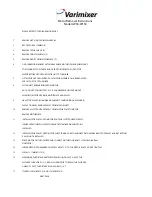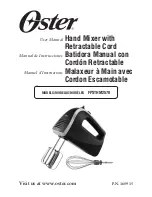
SPECIFICATIONS
Type:
PR 189
POWER AMPLIFIER SECTION:
Power output:
520 Watts R.M.S. @ 2 Ohms
350 Watts R.M.S. @ 4 Ohms
Distortion at 520 watts:
Less than .2% @ 1 kHz into 2 Ohms
Minimum load impedance:
2 Ohms
Sensitivity:
1.28V R.M.S.
Input impedance:
22K ohm
DELTACOMP range:
20 dB
PREAMP SECTION:
Input impedance:
LOW-Z
1.82k
HI-Z
18.2k
Hi-Z Input Sensitivity for 520 watts:
55 mV
(MAIN MASTER and CHANNEL
Main at maximum,all tone controls
and GEQ at "0" detent).
Channel tone controls:
LOW +/- 15 dB at 100 Hz
MID
+/- 15 dB at 750 Hz
HIGH +/- 15 dB at 10 kHz
Graphic equalizer:
+/- 12 dB at 63, 125, 250, 500, 1k,
2k, 4k, 8k, and 16kHz.
Dimensions:
SR 6520PD
SR 8520PD
Height:
10-7/16 inches (26.5 cm)
10-7/16 inches (26.5 cm)
Width:
23-5/8 inches (60.0 cm)
27-5/8 inches (70.2 cm)
Depth:
12 inches (30.5 cm)
12 inches (30.5 cm)
Weight:
40.0 lbs. (18.2 kg)
42 lbs. (19.1 kg)
CIRCUIT DESCRIPTION
POWER AMPLIFIER:
The signal from the preamp feeds from P1B pin 4, through a ribbon cable, to P1A on the
power amplifier PCB. The signal couples (via C1) to the unity gain amplifier U1B. U1B contains a closed loop (gain of
1) negative feedback path, along with positive feedback through the inverting Operational Transconductance Amplifier
(OTA) U2. U1B and U2 make up the gain reduction circuit for the DELTACOMP
clip protection feature.
The attack and release circuit for the DELTACOMP
is made up by the Diode, Resistor, and Capacitor network which
drives the Base of Q29. Comparator U1A senses the voltage from the Collectors of Q27 & Q28. When the power
amplifier approaches clipping on a positive swing, the collector of Q9 pulls up R50, which turns on Q28, transferring -
15vdc to the collector, pulling down R52. This causes the output (pin 1) of U1A to switch from +15vdc to -15vdc,
lighting the DELTACOMP
/Clip Led. Note when the DELTACOMP
is disabled, the Led indicates clipping of the
output stage. With the DELTACOMP
enabled, the Led indicates an active DELTACOMP
circuit. The negative
control voltage from R52 also feeds through P1A to P1B on the preamp PCB. The voltage is routed to the
DELTACOMP
switch (S1), located on the front panel. With the switch engaged, the control voltage is sent back
through the ribbon cable (via P1 pin 6) to the attack/release circuit.
The negative voltage drives through Diodes CR34 - CR37, and charges Capacitors C26-C29 all at once in parallel as
a one pole filter through a single time constant of R52 X (C26+27+28+29) or 3.9K X 8.8µF = 34.3ms. As they charge,
Q29 turns on and provides current to pin 5 of the OTA (U2). The current controls the output amplitude of U2. The
inverted signal from U2 mixes with the input to U1B providing cancellation which reduces the input to the power
amplifier. This prevents the amplifier from clipping. When the output of the power amplifier is reduced, the output of
U1A toggles back to +15vdc. Due to the blocking action of Diodes CR34 - CR37, Capacitors C26-C29 are forced to
discharge as a 4-pole filter with different time constants through R58. R62 prevents Parasitic oscillation while Zener
CR38 provides 2 slopes which results in smoother limiting.
When the power amplifier approaches clipping on a negative swing, R46 is pulled low, turning on Q26 which pulls up
the Base of Q27 transferring -15 vdc to the collector.
JFET Q1 and associated components provide a 4-5 second turn-on delay for the audio input to the power amplifier.
When the power is switched on, Capacitor C3 charges through Resistor R4. The negative Gate voltage pinches off the
JFET, removing the ground from the input of the amplifier. When the power is switched off, C3 immediately discharges
through Diode CR1, grounding the input of the amplifier.
TROUBLESHOOTING TIP:
Check for proper operation of this circuit when experiencing excessive turn-on or turn
off "Pops", or no output when signal applied to the input. Many times the JFET itself can be the culprit.
NOTE:
Excessive turn-off "Pops" can also be caused by uneven discharge of the +/- power supplies. Usually a mismatch in
the Filter Capacitors will cause this problem. Its easy to look at both supplies on an oscilloscope. Invert one scope
input and check for even discharge to zero volts.
Q4 is the current source for the Differential Amplifier (Q2, Q3). For the Diff amp to work properly, one half of the
current from the current source must flow through each leg of the Diff amp. If the same amount of current flows
through each leg of the Diff amp, the voltage drop across resistors R12 & R13 must be the same. If not, there will be a
DC offset at the output of the amplifier. The overall gain of the amplifier is set up around the Diff amp. R15 (27K) is the
feedback resistor and R14 (1K) is the pull-down resistor. Rfb + Rpd
÷
Rpd = Av. Therefore 27K + 1K
÷
1K = 28K
÷
1K
= 28 Av.
2






























